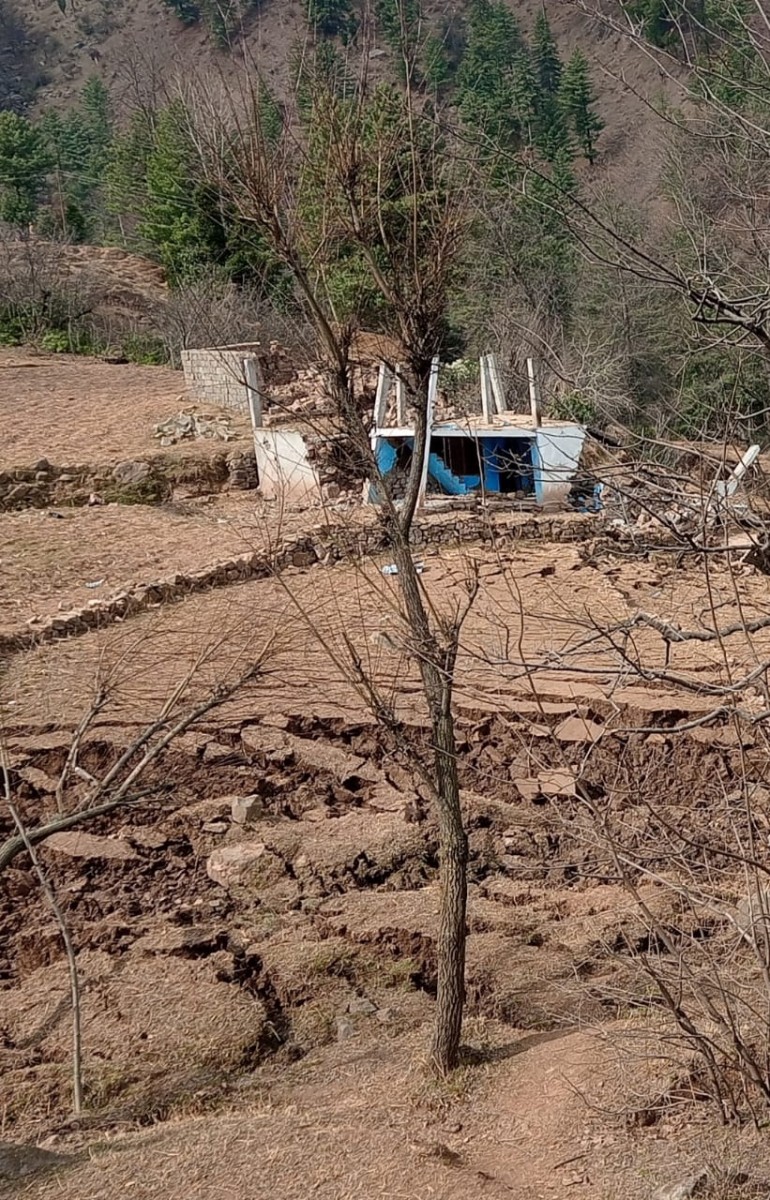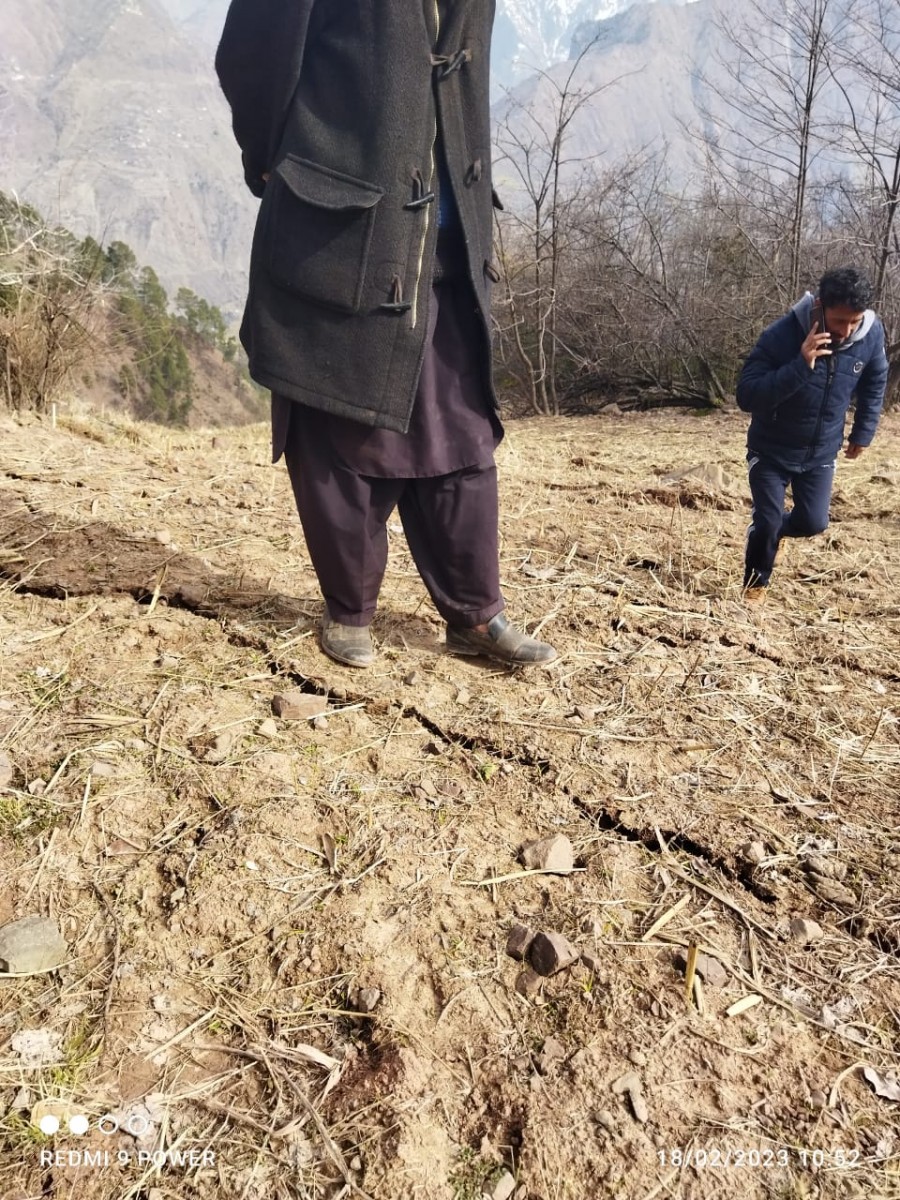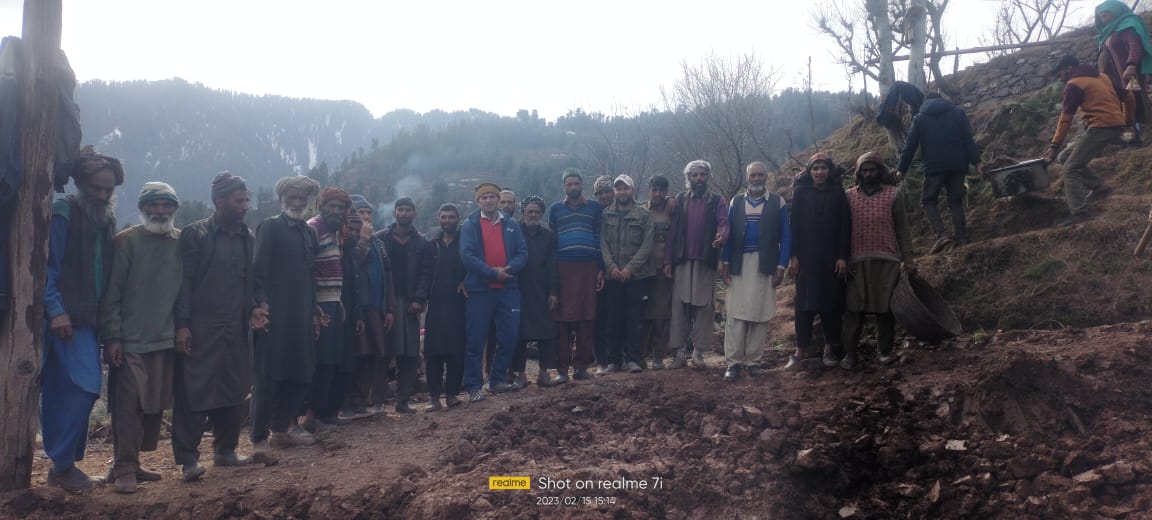'Doomsday in Slow Motion': Land Subsidence Destroys Homes in J&K's Ramban
Srinagar: Panicking at the distant clatter of rockfall in the higher reaches of a forest bordering his village, Fareed Ahmad, a mentally unwell farmer who raises two cows and a buffalo for a living, rang up his elder brother, Sabir Ali, pleading him to check out the cause of the disturbance.
“As I walked in darkness towards his house with a torch in my hand,” Sabir, a farmer in J&K’s Ramban district, said, “the earth appeared to have torn open; I could see big cracks, some of them as wide as one foot. I am glad that we shifted to my house at night itself because when we returned in the morning, the house was gone.”
On the night of February 17, Friday, residents of Duksar village in Ramban were awakened by similarly terrorising sounds from the forest triggered by a massive land subsidence, which has torn open nearly a 500-metre-long chunk of land in the mountainous village located in Gool tehsil of Jammu division.
Duksar is a village of low-income farmers who depend on their small farms and milk produced by their cattle to sustain their families. The land subsidence has rendered dozens of poor people, including children and women, homeless and landless. A major 33KV power transmission line in the district connecting Sangaldan and Gool has also been damaged, plunging parts of the district into darkness. Officials said that the restoration work is expected to be completed by Sunday.

Cracks in the land in Ramban. Photo: Special arrangement
While Fareed, father of three minor children, shifted his cattle to his brother’s house in time, his house along with its belongings was swallowed in the geological event, the cause of which is being ascertained by a two-member team of Geological Survey of India (GSI) which visited the area on Wednesday. Officials said three more houses have been permanently damaged in the village while 12 other houses are partially damaged.
Locals, however, told The Wire that at least 30 houses have been impacted by the land subsidence. While four houses have become unlivable, Fareed and his three brothers, one of whom passed away in 2018, have also been robbed of their only, 20 kanal ancestral land which sustained their families, including their 13 children, some of whom have their own families.
“We grew vegetables and maize to sustain our families. Our cattle fed off the abundant grass that grew on the land. With public goodwill and the government’s help, we are hoping to rebuild our houses. But without land, how are we going to survive?” Sabir said.
The tragedy in Ramban district took place days after Nai Basti village in Thathri town of the adjoining Doda district was brought to the verge of destruction due to land subsidence on February 3. Locals have blamed the tragedy on unabated dynamite blasts and hill cutting for building roads and power projects in the district.
The subsiding of Nai Basti village, also in Jammu division, has prompted the National Green Tribunal to form a panel headed by the J&K chief secretary, which has been asked to conduct a probe and suggest “stringent preventive and remedial measures” to avoid such occurrences in the eco-sensitive Himalayan region.
The twin tragedies in Jammu have taken place at a time when environmental experts across the country are urging the government to take a judicious view of the unabated road expansion into the Himalayan mountains in the aftermath of the land subsidence near Joshimath in Uttarakhand which has damaged more than 800 houses so far, apparently due to National Thermal Power Corporation's Tapovan Vishnugad Hydro Power Project.
Experts have termed the road and hydropower projects straddling the ecologically fragile mountains as environmental vandalism which has put the lives and livelihood of the residents living close to these projects in the hilly areas at risk. Earlier this week, a massive landslide damaged more than dozen structures in Rezan village of central Kashmir’s Ganderbal district.

Cracks in the land in Ramban. Photo: Special arrangement
Locals of Rezan, who spoke to The Wire, claimed that the blasting activities carried out in the mountains in the higher reaches of Gagangeer near Sonamarg resort of Ganderbal to make way for the Z-Morh tunnel on Srinagar-Leh highway led to gradual land subsidence over the last two years.
“We kept requesting the administration to stop the blasting activities because our houses rattled from the impact of the explosions. But our pleas fell on deaf ears which ultimately ended in the destruction of houses while dozens of cows, sheep, horses and other animals also perished,” said a villager, wishing to remain anonymous.
The simmering anger in Rezan village has prompted the district administration to order a probe into the incident. Deputy commissioner Ganderbal Shyambir told a local daily that relief had been provided to the affected families. “An inquiry will be initiated on what led to the incident,” he said.
The hilly district of Ramban has also seen a flurry of construction activities involving the expansion of the Srinagar-Jammu National Highway 44, the only all-weather road which connects Kashmir with the rest of the country. The National Highway Authority of India-hired contractor is boring through the mountains in the district to build three key tunnels that will bypass crucial stretches of the highway, which often get blocked due to shooting stones.
However, deputy commissioner, Ramban, Massarat Islam, said that the expansion work on NH-44 was not responsible for the land subsistence in Duksar village. “The affected area is very far from the highway. A GSI team has surveyed the area and it will file a report very soon,” Islam told The Wire.
Mohammad Raqeeb, a former sarpanch of Dalwah, claimed that the village has never witnessed land subsidence and that it was for the first time that such large-scale destruction has been witnessed in Ramban, “Even though Duksar is located on top of a mountain, such widespread land subsidence has never occurred in the village as far as I can remember,” he said.
Amid a flurry of official visits, the administration has pitched nearly dozen tents near a forested area for the uprooted residents of Duksar, some of whom, like Fareed, have shifted to their relatives’ houses, till they can get back on their own feet again, which looks like a remote possibility.
“My house has survived so far,” said Sabir Ali, who lives barely 200 metres from Fareed’s destroyed house, "but it too is under threat now. My brother is living with me but where will the poor people go with their children and livestock who don’t have any relatives? Who will provide them shelter?”

Locals looking over the remains of Fareed's house. Photo: Special arrangement
Abdul Gani Pahlo, whose houses in Duksar was also completely damaged, said that the government must help the affected families in restarting their lives. “The administration told us we will be provided small pieces of land for constructing houses but that there was no provision in law for the loss of land. In such a situation, how are we going to survive?”
More than five days after the village began to subside, officials said that the land subsidence has not stopped yet, keeping a key intra-district road between Gool and Sangaldan out of bounds. In a state of helplessness, anguished residents are watching the tragedy unfold every day in front of their eyes.
“It is like a doomsday in slow motion,” said Bashir Ahmad Gujjar, one of the affected farmers from Duksar. “Even the trees and farms are cascading into a deep gorge down the village. We have not only lost our homes and land; our history is also being erased.”
This article went live on February twenty-third, two thousand twenty three, at zero minutes past six in the evening.The Wire is now on WhatsApp. Follow our channel for sharp analysis and opinions on the latest developments.




